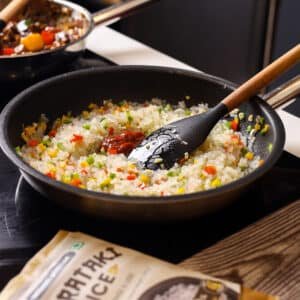
How to Make Konjac Noodles | A B2B Guide to Crafting Quality
- Andrew Yang
- 19 8 月, 2023
- 3:35 上午

Table of Contents
Konjac noodles, also known as Shirataki noodles is renowned for their health benefits and versatility, and have become a sought-after addition to menus across the culinary landscape. In this comprehensive guide, we’ll delve into the art of making Konjac noodles, catering specifically to B2B entities such as restaurants, food manufacturers, and distributors. Whether you’re a chef looking to offer a unique dish or a business seeking to expand your product line, this guide will equip you with the knowledge to create top-tier Shirataki noodles.
However, the potential of Shirataki noodles extends beyond the individual consumer. This guide is tailored to B2B stakeholders, providing insights into the intricate process of crafting quality konjac noodles for diverse culinary endeavors.
The culinary world is ever-evolving, with consumer demands driving innovation. Konjac noodles have emerged as a response to the growing need for healthier and gluten-free alternatives, sparking interest among B2B players seeking to enhance their offerings.
Essential Ingredients and Equipment
Firstly, embarking on the journey of Konjac noodle creation requires a clear understanding of the foundational components. At the heart of Shirataki noodles lies Konjac flour, extracted from the root of the Konjac plant. This essential ingredient serves as the canvas upon which culinary excellence is crafted. The marriage of Konjac flour and water forms the basis of the noodle dough. Precise mixing equipment ensures thorough incorporation, setting the stage for the noodle-making process.
The Konjac Noodles Production Process
Secondly, creating konjac noodles demands attention to detail, as each step contributes to the final product’s quality. Balancing the konjac flour-to-water ratio is pivotal. Proper mixing produces a cohesive dough that transforms into noodles with the desired characteristics. The dough then undergoes shaping and cutting into noodle strands. Techniques vary, offering opportunities for customization in thickness and length. Boiling the newly formed noodles ensures their readiness for consumption. Rapid cooling halts the cooking process, preserving the desired texture and quality.
Ensuring Consistency and Quality
Further, maintaining consistent Konjac noodle production requires meticulous attention to key factors. Consistency begins with precision in measuring ingredients and adhering to established ratios. Deviations can affect the final outcome. Routine quality control checks guarantee that each batch meets established standards. Rigorous testing ensures the noodles’ appearance, texture, and flavor align with expectations.
Flavor and Texture Customization
Further, crafting Konjac noodles allows for creative exploration of flavor and texture. Infusing konjac noodles with flavors can elevate the dining experience. This customization caters to diverse palates and culinary preferences. Tailoring the texture of Shirataki noodles is possible, offering options ranging from chewy to tender. Precise cooking times and cooling methods contribute to achieving the desired mouthfeel.
Packaging and Distribution Considerations
Presenting Konjac noodles to the market requires meticulous packaging and distribution strategies. Airtight packaging prevents moisture absorption, preserving the noodles’ freshness and quality. Storage conditions and shelf life considerations are paramount to delivering a consistent product to B2B clients.
Menu Integration and Culinary Creativity
Konjac noodles offer an avenue for culinary innovation and menu enhancement. Adding konjac noodle dishes to restaurant menus can attract health-conscious diners seeking unique options. Collaborating with chefs unlocks creative potential, resulting in unique dishes that cater to evolving culinary trends.
B2B Collaboration and Networking
Strengthening B2B relationships further is integral to success in the culinary industry. Open communication with suppliers and distributors ensures a steady supply of quality Shirataki noodles. Partnerships with B2B clients can lead to mutually beneficial collaborations, expanding the reach of Konjac noodles.
FAQs (Frequently Asked Questions)
- Can B2B clients tailor Shirataki noodles to their specific dietary requirements? Absolutely, the versatile nature of konjac noodles allows for customization to meet various dietary preferences.
- What culinary styles suit Shirataki noodles best? Shirataki noodles complement a wide range of culinary styles, from Asian-inspired dishes to Western cuisines.
- Do variations of Shirataki noodles benefit different dishes? Yes, Shirataki noodles can be produced in various shapes and sizes to suit different dishes, from soups to stir-fries.
- How can B2B clients ensure consistent quality when using Shirataki noodles? Regular quality checks, adherence to production protocols, and collaboration with reputable suppliers contribute to consistent quality.
- Is large-scale food production feasible for Shirataki noodles? Absolutely, with proper production planning and equipment, Shirataki noodles can be efficiently produced on a large scale for B2B purposes.
In conclusion, this guide has illuminated the intricate process of crafting top-tier Konjac noodles, tailored to the needs of B2B entities. By comprehending the ingredients, techniques, customization potentials, and B2B collaboration strategies, you position yourself to provide exceptional Konjac noodles that cater to evolving culinary preferences. As the culinary landscape evolves, embrace the art of konjac noodle creation and position your business at the forefront of innovation.
🍜 Read Next: 5 Facts About Konjac Noodles Nutrition You Must Know 🍜













